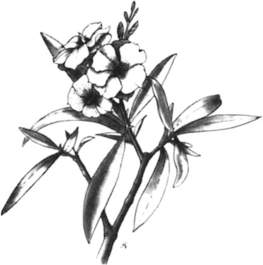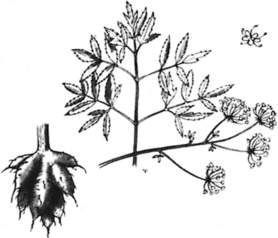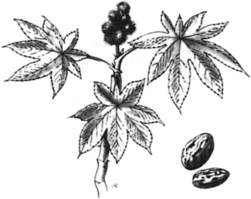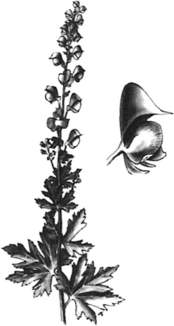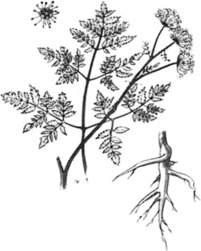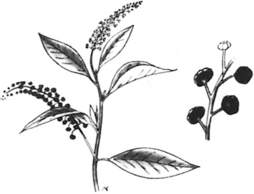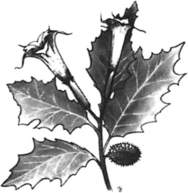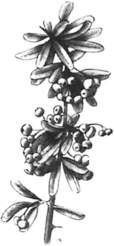WILD PLANT AND MUSHROOM POISONING
Toxic plants and mushrooms may be eaten by curious children, or by hikers and amateur herbalists who mistake their selections for edible species. Never eat wild plants, mushrooms, roots, or berries unless you know what you—re doing. Bees that collect nectar from poisonous plants might theoretically manufacture poisonous honey, but that would be highly unlikely unless all of the bees in the hive collected their nectar from poisonous plants.
MEDICAL HISTORY
2. What parts of the plant were eaten? How many different plants were eaten?
3. What symptoms does the victim have? What were the initial symptoms (sweating, hallucinations, vomiting, abdominal pain)? What was the time interval between the ingestion and the onset of symptoms? Did anyone who did not eat the plant(s) develop similar symptoms? Did everyone who ate the plant(s) become ill?
4. Was the plant eaten raw, or was it cooked? How was it cooked? Was alcohol consumed within 72 hours of the plant ingestion?
COMMONLY INGESTED TOXIC PLANTS AND MUSHROOMS
1. Oleander (Figure 218) is a shrub, up to 20 ft (6 m) tall, commonly found along highways and in gardens. It carries attractive clusters of red, pink, or white flowers. The entire plant is toxic, including smoke from burning cuttings and water in which the flowers are placed. There have been deaths from use of the branches as skewers for roasting hot dogs. Symptoms begin 1 to 2 hours after ingestion and include nausea, vomiting, abdominal cramps, diarrhea, confusion, and blurred vision. In serious ingestions, the heart’s rhythm may be disturbed.
2. Foxglove (Figure 219) is a European import that has toxic leaves and toxic tubular pink or purple flowers. Poisonings occur from ingestion of the plant parts or from foxglove tea. The symptoms are the same as those of oleander ingestion.
3. Water hemlock (“beaver poison”) (Figure 220) is found in saltwater and freshwater marshes and along riverbanks. A member of the carrot family, the plant grows to 6 ft (1.8 m) and has clusters of whitish, heavily scented flowers, along with a bundle of tuberous roots. It is easily confused with wild parsnip, celery, or sweet anise. When injured, the stem and trunk exude a yellow oil that smells like celery or raw parsnip. The entire plant is toxic. Symptoms begin 15 to 60 minutes after ingestion and include excessive salivation, abdominal pain, diarrhea, and vomiting. In a serious ingestion, the victim may suffer seizures and collapse, while having difficulty breathing. Death may occur.
4. Castor bean (Figure 221) is a treelike shrub that may grow to 15 ft (4.6 m) with clusters of spiny seedpods, which contain seeds with coats that resemble pinto beans. The seeds contain a potent toxin (ricin) that causes immediate mouth burning and abdominal pain, followed by vomiting, diarrhea, abnormal heart rhythms, and collapse.
5. Monkshood (Figure 222) is a flowering plant with tuberous roots and blue helmet-shaped flowers. The leaves and roots are particularly toxic. Ingestion causes immediate mouth and throat burning, followed by vomiting, diarrhea, headache, muscle cramps, sweating, drooling, blurred vision, and confusion. In a serious ingestion, there may be abnormal heart rhythms and collapse.
6. Poison hemlock (Figure 223) is a marsh plant that grows to 9 ft (2.7 m) with leaves that resemble a carrot top. The white flowers are clustered and smell like urine if they are crushed. The seeds and white unbranched tuberous roots are also toxic. The symptoms are similar to those of water hemlock ingestion, without significant abdominal pain or diarrhea. Death may follow seizures or paralysis with breathing failure.
7. Pokeweed (Figure 224) is a widely distributed plant with clusters of white flowers and plentiful round purple berries. Ingestion of the root (commonly mistaken for horseradish) or the berries (a favorite of children) causes the intoxication. Symptoms include sore mouth, tongue, and throat (delayed by 2 to 3 hours); thirst; nausea; vomiting; abdominal cramps; and diarrhea, which may become bloody. The illness can be severe and last for up to 2 days, particularly if the roots were ingested.
8. Rhododendrons (Figure 225) are common flowering plants that contain a number of toxins. Poisoning has occurred following ingestion of honey made from the flower nectar. Symptoms include mouth burning, followed by drooling, vomiting, diarrhea, headache, and numbness and tingling. Serious ingestions cause weakness, blurred vision, seizures, and collapse.
9. Jimsonweed (Figure 226) has white or purple flowers, with prickly seedpods. Adults sometimes ingest a tea made from the leaves or flowers. The entire plant is toxic. Symptoms include dry mouth, rapid heartbeat, hot and dry skin, weakness, difficulty walking, dilated pupils, and inability to urinate. Severe poisonings cause fever and collapse.
10. Skunk cabbage (Figure 227) is a marsh and forest plant that grows to 6 ft (1.8 m) and has broad pleated leaves. The entire plant is toxic and causes symptoms similar to those that follow ingestion of monkshood, but generally much less severe.
11. Pyracantha (Figure 228) is a thorned shrub with white flowers and clusters of small red berries. Ingestion of the berries in large quantities causes nausea and diarrhea. Birds sometimes eat fermented pyracantha berries and become intoxicated. Scratches from the thorns may cause a burning skin irritation.
12. Amanita phalloides (death cap) is a gilled mushroom (Figure 229) with a shiny yellow to greenish cap found in the western United States. The entire mushroom is toxic and cannot be detoxified by cooking. Symptoms occur 6 to 12 hours after ingestion and include abdominal pain; persistent nausea, vomiting, or diarrhea; low blood pressure; and rapid heartbeat. The victim may appear normal for the next few days, but then rapidly shows signs of massive liver inflammation and destruction, which include jaundice (yellow skin and eyeballs, darkened urine), easy bleeding, and altered mental status. Fatalities are frequent with this species, as well as with Galerina autumnalis.
Most nonfatal mushroom toxins act rapidly, producing symptoms of nausea, vomiting, diarrhea, and headache within 1 to 4 hours. Severe abdominal pain and headache approximately 6 hours after ingestion are likely due to Gyromitra esculenta. Typically, diarrhea and vomiting caused by ingestion of Amanita phalloides are delayed by 6 to 12 hours. However, because most unknowledgeable mushroom foragers eat a mixture of species, a rapid onset of symptoms does not rule out a potentially disastrous ingestion. Approximately 7 to 10 species of the several thousand varieties of wild mushrooms in the United States can cause death by ingestion.
13. Amanita muscaria (fly agaric) is a gilled mushroom (Figure 230) with a variably colored (yellow, red, warty, and so on) cap. Most poisonings are intentional, because people brew and drink Amanita tea for its hallucinogenic effects. Symptoms occur 30 minutes to 2 hours after ingestion and include euphoria, difficulty walking, dizziness, hallucinations, and blurred vision. Severe ingestions can result in seizures and death.
14. Coprinus atramentarius (inky cap) is a gilled fungus (Figure 231) with a conical cap that liquefies and turns black when picked. If alcohol is consumed within 24 to 72 hours after ingestion of the fungus, the victim suffers abdominal pain, vomiting, sweating, facial flushing, and headaches. Cortinarius rainierensis may cause the victim to have enormous thirst and increased urination 3 to 17 days after ingestion, due to a toxic effect on the kidneys.
Stay updated, free articles. Join our Telegram channel

Full access? Get Clinical Tree


